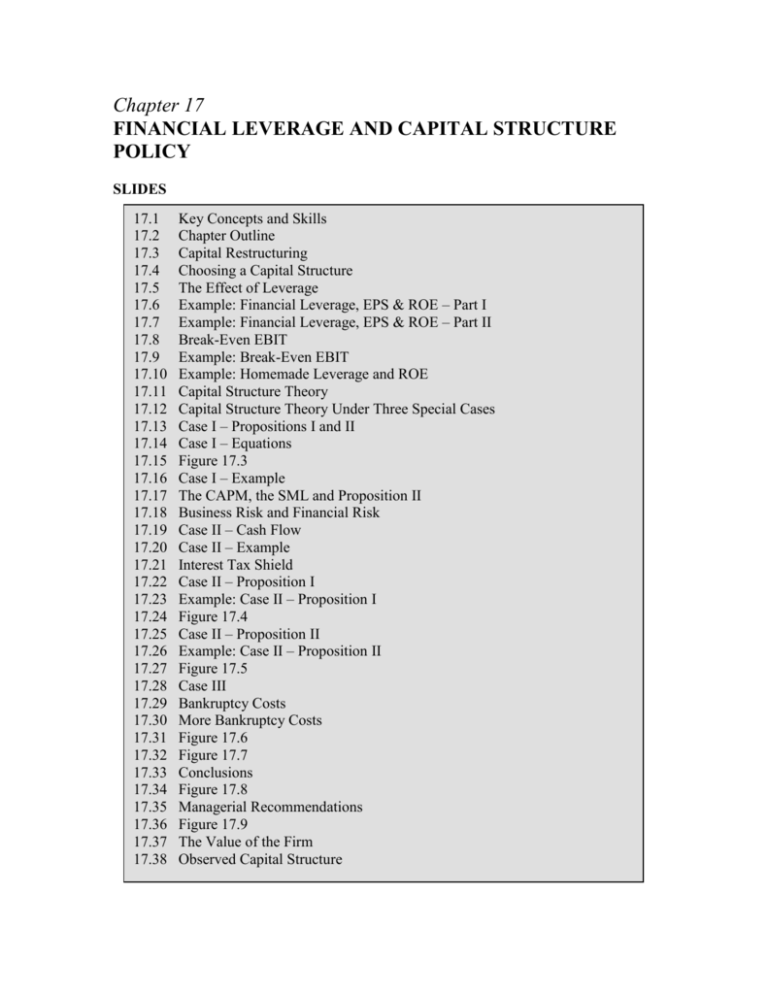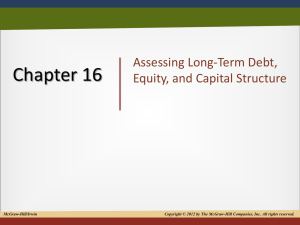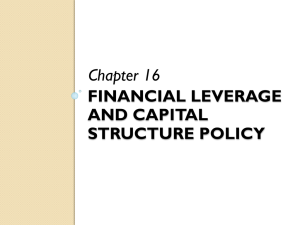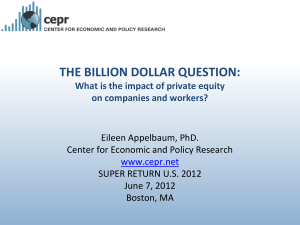chapter web sites
advertisement

Chapter 17 FINANCIAL LEVERAGE AND CAPITAL STRUCTURE POLICY SLIDES 17.1 17.2 17.3 17.4 17.5 17.6 17.7 17.8 17.9 17.10 17.11 17.12 17.13 17.14 17.15 17.16 17.17 17.18 17.19 17.20 17.21 17.22 17.23 17.24 17.25 17.26 17.27 17.28 17.29 17.30 17.31 17.32 17.33 17.34 17.35 17.36 17.37 17.38 Key Concepts and Skills Chapter Outline Capital Restructuring Choosing a Capital Structure The Effect of Leverage Example: Financial Leverage, EPS & ROE – Part I Example: Financial Leverage, EPS & ROE – Part II Break-Even EBIT Example: Break-Even EBIT Example: Homemade Leverage and ROE Capital Structure Theory Capital Structure Theory Under Three Special Cases Case I – Propositions I and II Case I – Equations Figure 17.3 Case I – Example The CAPM, the SML and Proposition II Business Risk and Financial Risk Case II – Cash Flow Case II – Example Interest Tax Shield Case II – Proposition I Example: Case II – Proposition I Figure 17.4 Case II – Proposition II Example: Case II – Proposition II Figure 17.5 Case III Bankruptcy Costs More Bankruptcy Costs Figure 17.6 Figure 17.7 Conclusions Figure 17.8 Managerial Recommendations Figure 17.9 The Value of the Firm Observed Capital Structure A-224 CHAPTER 17 SLIDES – CONTINUED 17.39 17.40 17.41 17.42 Work the Web Example Bankruptcy Process – Part I Bankruptcy Process – Part II Quick Quiz CASES The following cases from Cases in Finance by DeMello can be used to illustrate concepts discussed in this chapter: Debt vs. Equity Financing EBIT-EPS Analysis Bankruptcy CHAPTER WEB SITES Section 17.5 17.8 17.9 End-of-chapter material Web Address www.abiworld.org yahoo.marketguide.com www.sec.gov/investor/ www.bankruptcydata.com www.amex.com CHAPTER ORGANIZATION 17.1 The Capital Structure Question Firm Value and Stock Value: An Example Capital Structure and the Cost of Capital 17.2 The Effect of Financial Leverage The Basics of Financial Leverage Corporate Borrowing and Homemade Leverage 17.3 Capital Structure and the Cost of Equity Capital M&M Proposition I: The Pie Model The Cost of Equity and Financial Leverage: M&M Proposition II Business and Financial Risk 17.4 M&M Propositions I and II with Corporate Taxes The Interest Tax Shield Taxes and M&M Proposition I Taxes, the WACC, and Proposition II CHAPTER 17 A-225 17.5 Bankruptcy Costs Direct Bankruptcy Costs Indirect Bankruptcy Costs 17.6 Optimal Capital Structure The Static Theory of Capital Structure Optimal Capital Structure and the Cost of Capital Optimal Capital Structure: A Recap Capital Structure: Some Managerial Recommendations 17.7 The Pie Again The Extended Pie Model Marketed Claims versus Nonmarketed Claims 17.8 Observed Capital Structures 17.9 A Quick Look at the Bankruptcy Process Liquidation and Reorganization Financial Management and the Bankruptcy Process Agreements to Avoid Bankruptcy 17.10 Summary and Conclusions ANNOTATED CHAPTER OUTLINE Slide 17.1 Slide 17.2 17.1. Key Concepts and Skills Chapter Outline The Capital Structure Question A. Firm Value and Stock Value: An Example The value of the firm equals the market value of debt plus the market value of equity (firm value identity). Notationally, this is just V = D + E. When the market value of debt is given and constant, any change in the value of the firm results in an identical change in the value of the equity. The key to this reasoning lies in the fixed nature of debt and the derivative nature of stock. Slide 17.3 Slide 17.4 Capital Restructuring Choosing a Capital Structure A-226 CHAPTER 17 B. Capital Structure and the Cost of Capital The “optimal” or “target” capital structure is that debt/equity mix that simultaneously (a) maximizes the value of the firm, (b) minimizes the weighted average cost of capital, and (c) maximizes the market value of the common stock. Maximizing the value of the firm is the goal of managing capital structure. Lecture Tip, page 569: Students sometimes fail to understand the mechanics of why “minimizing WACC maximizes firm value.” Remind students that a firm is just a portfolio of projects, some with positive NPVs and some with negative NPVs when evaluated at the WACC. The value of the firm is the sum of the NPVs of its component projects. We already know that lower discount rates increase NPVs, consequently, decreasing the WACC will increase firm value. 17.2. The Effect of Financial Leverage A. The Basics of Financial Leverage Slide 17.5 The Effect of Leverage Slide 17.6 Example: Financial Leverage, EPS & ROE – Part I Click on the Excel icon to go to a spreadsheet that contains the example information for the example presented below. Slide 17.7 Example: Financial Leverage, EPS & ROE – Part II Example (additional example from the one in the book) Assets Debt Equity D/E ratio Share price (assume it doesn’t change when shares are repurchased) Shares outstanding Interest Rate Current Proposed $5,000,000 $5,000,000 0 2,500,000 5,000,000 2,500,000 0 1 $10 $10 500,000 N/A 250,000 10% CHAPTER 17 A-227 Current capital structure: No debt Recession Expected Expansion EBIT $300,000 $650,000 $800,000 Interest Expense 0 0 0 Net Income $300,000 $650,000 $800,000 ROE 6% 13% 16% EPS $0.60 $1.30 $1.60 Proposed capital structure: D/E = 1; interest rate = 10% Recession Expected Expansion EBIT $300,000 $650,000 $800,000 Interest Expense 250,000 250,000 250,000 Net Income $50,000 $400,000 $550,000 ROE 2% 16% 22% EPS $0.20 $1.60 $2.20 Lecture Tip, page 571: You may wish to provide the following example to better solidify the students’ understanding of the variability in ROE due to leverage. Ask the class to consider the difference between ROE and ROA for an all equity firm given various sales levels. It’s easy to show that ROE = ROA in this case because total equity = total assets. The substitution of debt for equity results in ROE equaling ROA at only one level of sales. The fixed interest expense and lower number of common shares outstanding cause ROE to change by a larger percentage than the change in ROA, for any given change in sales. Slide 17.8 Break-Even EBIT Slide 17.9 Example: Break-Even EBIT Click on the Excel icon to see the graph that illustrates the cross-over point. We can conclude that: -The effect of financial leverage depends on EBIT -Financial leverage increases ROE and EPS when EBIT is greater than the cross-over point -The variability of EPS and ROE is increased as leverage increases Lecture Tip, page 573: Many students feel that if a company expects to achieve the break-even EBIT, it should automatically issue debt. You should emphasize that this is a break-even point relative to EBIT and EPS. Beyond this point, EPS will be larger under the debt alternative, but with additional debt, the firm will have additional financial risk that would increase the required return on its common stock. A higher required return might offset A-228 CHAPTER 17 the increase in EPS, resulting in a lower firm value despite the higher EPS. The M&M models, described in upcoming sections, will offer key points to make about this relationship. B. Corporate Borrowing and Homemade Leverage Homemade leverage – if all market participants have equal access to the capital markets, there’s nothing special about corporate borrowing. Slide 17.10 Example: Homemade Leverage and ROE Suppose the firm in the previous example does not change its capital structure. An investor can replicate the returns of the proposed borrowing by making her own D/E ratio equal to 1 for the investment. Suppose an investor buys 50 shares with her own money and 50 shares by borrowing $500 at 10% interest. The payoffs are: Recession Expected Expansion EPS – unlevered firm $0.60 $1.30 $1.60 Earnings for 100 shares $60.00 $130.00 $160.00 Less interest on $500 at 10% 50.00 50.00 50.00 Net earnings $10.00 $80.00 $110.00 Return on investment = net earnings / $500 2% 16% 22% The investor has been able to convert her return to what she would have gotten if the company had undertaken the proposed capital structure. Suppose instead the firm does switch to the proposed capital structure. An investor can “unlever” the firm by purchasing both the firm’s stock and bonds. Consider an investor who invests $250 in the stock and $250 in the bonds paying 10%. (Note that in both situations, the investor’s total cash outlay is $500.) Recession Expected Expansion EPS – levered firm $0.20 $1.60 $2.20 Earnings for 25 shares 5.00 40.00 55.00 Plus interest on $250 at 10% 25.00 25.00 25.00 Net earnings $30.00 $65.00 $80.00 Return on investment = net earnings / $500 6% 13% 16% CHAPTER 17 A-229 In this case, the investor is able to earn the same return as she would have earned if the firm did not change capital structure and she just invested in stock. 17.3. Capital Structure and the Cost of Equity Capital A. M&M Proposition I: The Pie Model M&M Proposition I – without corporate taxes and bankruptcy costs, the firm cannot affect its value by altering its capital structure. Slide 17.11 Capital Structure Theory Slide 17.12 Capital Structure Theory Under Three Special Cases B. The Cost of Equity and Financial Leverage: M&M Proposition II M&M Proposition II – a firm’s cost of equity capital is a positive linear function of its capital structure (still assuming no taxes): WACC = RA = (E/V)RE + (D/V)RD; RE = RA + (RA – RD)(D/E) As more debt is used, the return on equity increases, but the change in the proportion of debt versus equity just offsets that increase and the WACC does not change. Lecture Tip, page 576: Many students wonder why we are even considering a situation in which taxes do not exist. We are trying to determine what risk-return trade-off is best for the firm’s stockholders. One way to get a good understanding of what is relevant to the capital structure decision is to start in a “perfect” world and then relax assumptions as we go. By relaxing one assumption at a time, we can get a better idea of the impact on the capital structure decision. This is the classic process of “model building” in economics – start simple and add complexity one step at a time. Slide 17.13 Slide 17.14 Slide 17.15 Slide 17.16 Case I – Propositions I and II Case I – Equations Figure 17.3 Case I – Example A-230 CHAPTER 17 Lecture Tip, page 577: According to Proposition II, RE = RA + (RA – RD)(D/E). An alternative explanation is as follows: In the absence of debt, the required return on equity equals the return on the firm’s assets, RA. As we add debt, we increase the variability of cash flows available to stockholders, thereby increasing stockholder risk. C. Business and Financial Risk You may wish to skip over the distinction between the asset beta and the equity beta. The key point is that Proposition II shows that return on equity depends on both business risk and financial risk. Business risk – the risk inherent in a firm’s operations; it depends on the systematic risk of the firm’s assets and it determines the first component of the required return on equity, RA Financial risk – the extra risk to stockholders that results from debt financing; it determines the second component of the required return on equity, (RA – RD)(D/E) Slide 17.17 The CAPM, the SML and Proposition II Slide 17.18 Business Risk and Financial Risk Lecture Tip, page 579: Some students may confuse the concepts of financial risk and default risk. Proposition II suggests that even if a firm could issue risk-free debt, its financial risk would exceed zero. Point out that the focus here is on the risk (and required return) to the shareholder. Regardless of the certainty associated with the promised returns to bondholders (default risk), higher levels of debt imply greater volatility of earnings to stockholders. 17.4. M&M Propositions I and II with Corporate Taxes Slide 17.19 Case II – Cash Flow A. The Interest Tax Shield Tax savings arising from the deductibility of interest. It is the key benefit from borrowing over issuing equity. Real-World Tip, page 579: “Wall Street Concocts New TaxSaving Ploy … Treasury Attacks Clever Way to Let Borrower Deduct Both Principal, Interest.” So reads a headline from the CHAPTER 17 A-231 November 6, 1997 issue of The Wall Street Journal. How is this accomplished? Here’s how it works. “First, the borrower and an investor each put up a certain amount, say $100, to create a real estate investment trust. The investor, a state pension fund or other tax-exempt organization, does so by buying preferred stock in the REIT. Next, in a typical case, the REIT lends its entire $200 to the borrower. The borrower pays the interest, but no principal, on the loan. The REIT, whose income isn’t taxable, passes all this money on to the investor in the form of high preferred-stock dividends. These dividends ‘step-down’ steeply to almost nothing after 10 years. By then, the investor has gotten most of its money back. It gets the rest back by selling the REIT preferred stock to the borrower. Finally, the REIT is merged into the borrower, giving the borrower its initial $100 back. Result, the borrower had a $100 loan for 10 years, a loan that is now paid off. It could deduct all payments, since none were principal repayments.” Slide 17.20 Case II – Example Slide 17.21 Interest Tax Shield B. Taxes and M&M Proposition I Annual interest tax savings = D(RD)(TC) If we assume perpetual debt, then the present value of interest tax savings = D(RD)(TC) / RD = DTC We also assume perpetual cash flows to the firm. This is done for simplicity, but the ultimate result is the same even if you use finite cash flows. Value of an unlevered firm, VU = EBIT(1 – TC)/RU; where RU is the cost of capital for an all equity firm. Value of a levered firm, VL = VU + DTC Slide 17.22 Case II – Proposition I Slide 17.23 Example: Case II – Proposition I Slide 17.24 Figure 17.4 A-232 CHAPTER 17 Lecture Tip, page 580: Slides 13.25 through 13.27 provide a discussion of the effect of corporate taxes on Proposition II. These slides can be hidden if you don’t wish to discuss it in class. Slide 17.25 Case II – Proposition II Slide 17.26 Case II – Proposition II Example Slide 17.27 Case II – Graph of Proposition II Lecture Tip, page 581: This is a good point at which to digress a bit on the idea that financing decisions can generate positive NPVs. Put simply, a positive NPV decision is one for which the firm obtains something for less than market value. Just as the relative inefficiency of the physical asset markets makes the search for positive NPV projects worthwhile, the efficiency of the financial markets makes positive NPV financing projects unlikely. This can change in the presence of financial market imperfections; and differential tax treatment between interest and dividends is a big market imperfection. Further discussion of the successes and failures of financial engineering in the last two decades may serve to illustrate the core concepts: (1) firm value comes largely from the asset side of the balance sheet and (2) positive NPV financing projects can also be created, but in general, financing is a zeroNPV proposition. Slide 17.27 Figure 17.5 17.5. Bankruptcy Costs Real-World Tip, page 584: In 1997, the remaining assets of Fruehauf Corporation, described by Barrons as “the oncedominant” manufacturer of truck trailers, were sold off for a mere $50 million, bringing an end to the story of a great firm laid low by over-reliance on debt financing. Founded in the 1940’s, the firm controlled one-third of the trailer market in the early 1980’s, but then went private in a leveraged buyout in 1986 to avoid a hostile takeover bid. Saddled with debt it found it difficult to service, the firm went through a number of restructurings until, by 1996, the firm filed for chapter 11, at which time its shares were delisted from the NYSE. And, as Barrons notes, “… the shareholders had been wiped out, leaving the carcass to be picked over by those with secure claims to Fruehauf’s assets … [b]lood was in the water.” By 1997, the last division was sold and the remaining assets were sold to Wabash National. CHAPTER 17 A-233 Slide 17.28 Case III A. Direct Bankruptcy Costs The key disadvantage to the use of debt is bankruptcy costs. Direct bankruptcy costs are the legal and administrative expenses directly associated with bankruptcy. Generally, these costs are quantifiable and measurable. Real-World Tip, page 585: As noted in the text, bankruptcy costs can be direct or indirect. Examples of direct costs such expenses as legal and accounting fees incurred by the firm upon filing for bankruptcy. Both empirical and anecdotal evidence indicate that direct costs can run into tens of millions of dollars, even for relatively small firms. For example, Apex Oil in St. Louis incurred over $20 million in legal and accounting claims before it emerged from bankruptcy. The key point is that those funds represented value not captured by the firm’s shareholders. Slide 17.29 Bankruptcy Costs Slide 17.30 More Bankruptcy Costs B. Indirect Bankruptcy Costs Indirect bankruptcy costs (e.g., difficulties in hiring and retaining good people because the firm is in financial difficulty) are hard to measure and generally take the form of foregone revenues, opportunity costs, etc. Financial distress – the direct and indirect costs of avoiding bankruptcy. 17.6. Optimal Capital Structure A. The Static Theory of Capital Structure -Firms borrow because tax shields are valuable -Borrowing is constrained by the costs of financial distress -The optimal capital structure balances the incremental benefits and costs of borrowing Slide 17.31 Figure 17.6 A-234 CHAPTER 17 B. Optimal Capital Structure and the Cost of Capital The optimal capital structure is that debt-equity mix at which the WACC is minimized. Slide 17.32 Figure 17.7 C. Optimal Capital Structure: A Recap Case I – No taxes or bankruptcy costs; firm value is unaffected by the choice of capital structure Case II – Corporate taxes, no bankruptcy costs; firm value is maximized when the firm uses as much debt as possible due to the interest tax shield Case III – Corporate taxes and bankruptcy costs; firm value is maximized where the additional benefit from the interest tax shield is just offset by the increase in expected bankruptcy costs – there is an optimal capital structure Slide 17.33 Conclusions Slide 17.34 Figure 17.8 D. Capital Structure: Some Managerial Recommendations Taxes – the higher the firm’s tax rate, the more important are tax shields Financial distress – the lower the risk of distress, the more likely a firm is to borrow funds Slide 17.35 Managerial Recommendations International Note, page 590: In theory, the static model of capital structure described in this section applies to multinational firms as well as to domestic firms. That is, the multinational firm should seek to minimize its global cost of capital by balancing the debtrelated tax shields across all of the countries in which the firm does business against global agency and bankruptcy costs. Among other things, however, this assumes that worldwide capital markets are well-integrated and that foreign exchange markets are highly efficient. In such an environment, financial managers would seek the optimal global capital structure. In practice, of course, the existence of capital market segmentation, differential taxes and regulatory frictions make the determination of the global optimum much more difficult than the theory would suggest. CHAPTER 17 A-235 17.7. The Pie Again A. The Extended Pie Model Cash Flow = Payments to stockholders (E) + Payments to creditors (D) + Payments to the government (G) + Payments to bankruptcy courts and lawyers (B) + Payments to all other claimants Slide 17.36 Figure 17.9 B. Marketed Claims versus Nonmarketed Claims Marketed claims – claims against cash flow that can be bought and sold (bonds, stock) Nonmarketed claims – claims against cash flow that cannot be bought and sold (taxes) VM = value of marketed claims VN = value of nonmarketed claims VT = value of all claims = VM + VN = E + D + G + B + … Given the firm’s cash flows, the optimal capital structure is the one that maximizes VM or minimizes VN Slide 17.37 The Value of the Firm 17.8. Observed Capital Structures Table 17.7 lists ratios of debt to total capital for several U.S. industries. Slide 17.38 Observed Capital Structure Slide 17.39 Work the Web Example 17.9. A Quick Look at the Bankruptcy Process Financial distress -Business failure – business terminates with a loss to creditors -Legal bankruptcy – bankruptcy is a legal proceeding for liquidating or reorganizing -Technical insolvency – when a firm defaults on a legal obligation -Accounting insolvency – happens when total book liabilities exceed total book assets A-236 CHAPTER 17 Bankruptcy – the transfer of some or all of the firm’s assets to creditors Slide 17.40 Bankruptcy Process – Part I Slide 17.41 Bankruptcy Process – Part II A. Liquidation and Reorganization Liquidation – termination of the business, selling off all assets Reorganization – keeping the business going, often issuing new securities to replace old Real-World Tip, page 595: On March 29, 1996 The Wall Street Journal announced that the trust set up to distribute the assets of Drexel Burnham Lambert, one of the most (in)famous investment banks of the 1980s, would complete the task ahead of schedule. Even more surprising to some was the fact that creditors received, on average, nearly 80 cents on the dollar for their claims. When the trust was established in 1992, experts had predicted that creditors would receive less than 20 cents on the dollar. Why was this liquidation so successful? Largely because securities values in general have risen nearly continually since the inception of the trust. Unfortunately, this case is an exception to the rule. Average receipts of 10 to 30 cents on the dollar are more typical. Bankruptcy liquidation (Chapter 7 or straight liquidation) – assets are sold and distributed to creditors in the order of the absolute priority rule Bankruptcy reorganization (Chapter 11) – involves a legal proceeding in which the company restructures its debt obligations. A plan is filed with the court and the various stakeholders have to agree on the plan. Lecture Tip, page 597: It has been said that Carl Icahn’s takeover of TWA in the early 1980s represents the quintessential example of the “80s two-step” – borrow extensively to take the firm private, then file for bankruptcy. Icahn, one of the most noted takeover artists of the period, was not as successful at running TWA as he had been with some of his other businesses. Following repeated losses, he sold the firm to the employees, who struggled mightily to put the firm back on its feet. Nonetheless, TWA filed for bankruptcy reorganization in 1992 and again in 1995. In each case, a portion CHAPTER 17 A-237 of firm ownership was transferred from the owners to the creditors in return for the latter’s willingness to eliminate a portion of the outstanding debt. B. Financial Management and the Bankruptcy Process The right to go bankrupt is valuable because it stops creditors from further draining assets from the firm, and may be used to improve the firm’s strategic position vis-à-vis its competitors. C. Agreements to Avoid Bankruptcy Voluntary arrangements to restructure debt are often made. Extension postpones the date of payment, while composition involves a reduced payment. 17.10. Summary and Conclusions Slide 17.42 Quick Quiz








